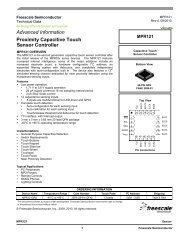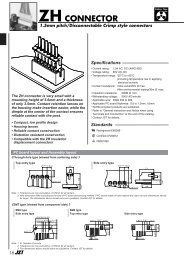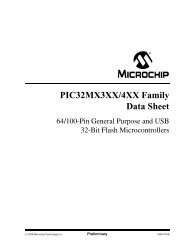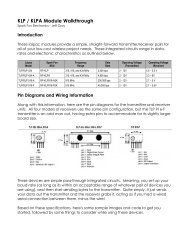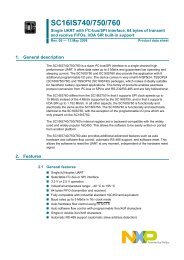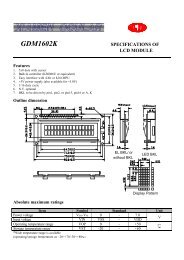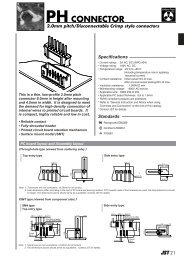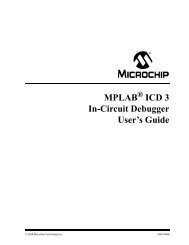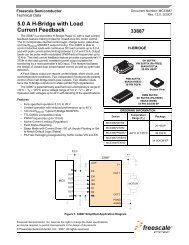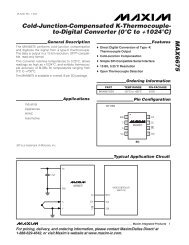PIC24HJ64 Datasheet
PIC24HJ64 Datasheet
PIC24HJ64 Datasheet
You also want an ePaper? Increase the reach of your titles
YUMPU automatically turns print PDFs into web optimized ePapers that Google loves.
PIC24HJ32GP302/304, <strong>PIC24HJ64</strong>GPX02/X04, AND PIC24HJ128GPX02/X04<br />
18.3 Modes of Operation<br />
The ECAN module can operate in one of several<br />
operation modes selected by the user. These modes<br />
include:<br />
• Initialization mode<br />
• Disable mode<br />
• Normal Operation mode<br />
• Listen Only mode<br />
• Listen All Messages mode<br />
• Loopback mode<br />
Modes are requested by setting the REQOP bits<br />
(CiCTRL1). Entry into a mode is Acknowledged<br />
by monitoring the OPMODE bits<br />
(CiCTRL1). The module does not change the<br />
mode and the OPMODE bits until a change in mode is<br />
acceptable, generally during bus Idle time, which is<br />
defined as at least 11 consecutive recessive bits.<br />
18.3.1 INITIALIZATION MODE<br />
In the Initialization mode, the module does not transmit<br />
or receive. The error counters are cleared and the interrupt<br />
flags remain unchanged. The user application has<br />
access to Configuration registers that are access<br />
restricted in other modes. The module protects the user<br />
from accidentally violating the CAN protocol through<br />
programming errors. All registers which control the<br />
configuration of the module can not be modified while<br />
the module is on-line. The ECAN module is not allowed<br />
to enter the Configuration mode while a transmission is<br />
taking place. The Configuration mode serves as a lock<br />
to protect the following registers:<br />
• All Module Control registers<br />
• Baud Rate and Interrupt Configuration registers<br />
• Bus Timing registers<br />
• Identifier Acceptance Filter registers<br />
• Identifier Acceptance Mask registers<br />
18.3.2 DISABLE MODE<br />
In Disable mode, the module does not transmit or<br />
receive. The module has the ability to set the WAKIF bit<br />
due to bus activity, however, any pending interrupts<br />
remains and the error counters retains their value.<br />
If the REQOP bits (CiCTRL1) = 001, the<br />
module enters the Module Disable mode. If the module is<br />
active, the module waits for 11 recessive bits on the CAN<br />
bus, detect that condition as an Idle bus, then accept the<br />
module disable command. When the OPMODE<br />
bits (CiCTRL1) = 001, that indicates whether the<br />
module successfully went into Module Disable mode.<br />
The I/O pins reverts to normal I/O function when the<br />
module is in the Module Disable mode.<br />
The module can be programmed to apply a low-pass<br />
filter function to the CiRX input line while the module or<br />
the CPU is in Sleep mode. The WAKFIL bit<br />
(CiCFG2) enables or disables the filter.<br />
Note:<br />
Typically, if the ECAN module is allowed to<br />
transmit in a particular mode of operation<br />
and a transmission is requested immediately<br />
after the ECAN module has been<br />
placed in that mode of operation, the module<br />
waits for 11 consecutive recessive bits<br />
on the bus before starting transmission. If<br />
the user switches to Disable mode within<br />
this 11-bit period, then this transmission is<br />
aborted and the corresponding TXABT bit<br />
is set and TXREQ bit is cleared.<br />
18.3.3 NORMAL OPERATION MODE<br />
Normal Operation mode is selected when<br />
REQOP = 000. In this mode, the module is<br />
activated and the I/O pins assumes the CAN bus<br />
functions. The module transmits and receive CAN bus<br />
messages via the CiTX and CiRX pins.<br />
18.3.4 LISTEN ONLY MODE<br />
If the Listen Only mode is activated, the module on the<br />
CAN bus is passive. The transmitter buffers revert to<br />
the port I/O function. The receive pins remain inputs.<br />
For the receiver, no error flags or Acknowledge signals<br />
are sent. The error counters are deactivated in this<br />
state. The Listen Only mode can be used for detecting<br />
the baud rate on the CAN bus. To use this, it is necessary<br />
that there are at least two further nodes that<br />
communicate with each other.<br />
18.3.5 LISTEN ALL MESSAGES MODE<br />
The module can be set to ignore all errors and receive<br />
any message. The Listen All Messages mode is activated<br />
by setting REQOP = ‘111’. In this mode,<br />
the data which is in the message assembly buffer, until<br />
the time an error occurred, is copied in the receive<br />
buffer and can be read via the CPU interface.<br />
18.3.6 LOOPBACK MODE<br />
If the Loopback mode is activated, the module connects<br />
the internal transmit signal to the internal receive<br />
signal at the module boundary. The transmit and<br />
receive pins revert to their port I/O function.<br />
© 2008 Microchip Technology Inc. Preliminary DS70293B-page 189




